
Maine Home Garden News – August 2024
In This Issue:
- August Is the Month to . . .
- What Can Devoted Gardeners Do When We Just Cannot Garden Anymore Like We Want To?
- Collecting Ash Seed in Maine
- Featured Tool: Say Hello to the Homi
- The Best Salts for Canning & Pickling
- Backyard Bird of the Month: Scarlet Tanager
- Maine Weather and Climate Overview (August 2024)
August Is the Month to . . .
Adapted from articles written by Tori Lee Jackson, Program Leader, Agriculture & Natural Resources, University of Maine Cooperative Extension

- Keep planting vegetables like beets, beans, broccoli, cauliflower, cabbage, lettuce, spinach, turnip and more for a fall crop. Here’s a handy chart to help you plan.
- Take pictures of the positive and less-than-perfect aspects of your landscape. One of the simplest methods of record keeping is to take pictures, but don’t portray everything as perfect if that’s not the reality. Documenting spotted leaves or misshapen fruit is valuable too. These images will be beneficial when you need to diagnose issues and understand how to effectively manage them in the future.
- Harvest your garlic and save some of the larger heads for replanting this fall. For more information about growing garlic, see Bulletin #2063, Growing Hardneck Garlic in Your Maine Garden.
- Onions may be ready for harvesting too! When 70-80% of the tops have fallen over, it’s time to undercut or pull the onions and begin curing them for storage. Learn more.
- Fix your lawn. Have some trouble spots or interest in reseeding your entire lawn? Mid-August through September is the best time of year to establish new grass. Check out Bulletin #2367, Establishing a Home Lawn in Maine, Bulletin #2243, Maintaining a Home Lawn in Maine and Bulletin #2166, Steps to a Low-Input, Healthy Lawn for tips and step-by-step instructions.
- Apply beneficial nematodes for white grub management. Timing and proper handling methods are important when applying these helpful organisms. Learn more.
- Start Monitoring for Spotted Wing Drosophila (SWD) if you have summer-ripening fruits. Late-season raspberries and elderberries are favorites of this invasive fruit fly. Learn how to make a simple trap. To see SWD counts in our traps, you can find weekly updates from Small Fruit and Vegetable Specialist, David Handley on this Highmoor Farm blog.
- Irrigate. Most crops benefit from having 1” of water a week. A rain gauge is a simple and inexpensive tool for monitoring whether Mother Nature is giving our gardens what they need. Instead of watering daily or every other day, water deeply once or twice a week to promote healthy root development and conserve resources over time.
- Attend Maine’s Agricultural Fairs! August is the peak fair season. Enter your famous pickles, pie, or artwork in the local fair and take in a tractor-pull or midway, too. Check out the Maine Department of Agriculture, Conservation & Forestry’s full schedule of 2024 Agricultural State Fairs. Here are your options this month:
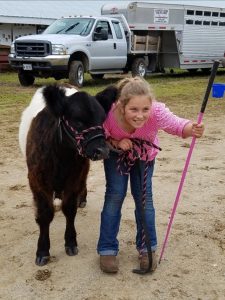
Photo credit: Corinna Caron.
º July 25 – Aug 3 Bangor State Fair – Bangor, Maine
º July 31 – Aug 4 Northern Maine Fair – Presque Isle, Maine
º Aug 6 – 11 Topsham Fair – Topsham, Maine
º Aug 8 – 17 Skowhegan State Fair – Skowhegan, Maine
º Aug 22 – 25 Acton Fair – Acton, Maine
º Aug 22 – 25 Piscataquis Valley Fair – Dover-Foxcroft, Maine
º Aug 24 – Sept 2 Windsor Fair – Windsor, Maine
º Aug 29 – Sept 2 Blue Hill Fair – Blue Hill, Maine
º Aug 30 – Sept 2 Harmony Free Fair – Harmony, Maine
º Sept 5 – Sept 8 Clinton Lions Agricultural Fair – Clinton, Maine
º Sept 6 – Sept 8 Litchfield Fair – Litchfield, Maine
º Sept 11 – Sept 14 Oxford County Fair – Oxford, Maine
º Sept 13 – Sept 15 New Portland Lion’s Fair – New Portland, Maine
º Sept 15 – Sept 21 Farmington Fair – Farmington, Maine
º Sept 20 – Sept 22 Common Ground Fair – Unity, Maine
º Sept 22 – Sept 28 Cumberland Fair – Cumberland Center, Maine
º Sept 29 – Oct 6 Fryeburg Fair – Fryeburg, Maine
- Preserve those summer flavors for the long winter ahead. UMaine Extension has lots of resources available to help you safely preserve the fruits and vegetables we are harvesting now. Whether you’re a first-timer or an old hand, there’s something for you on our Food Preservation site.
- Share the fruits (and vegetables) of your labor. Learn how gardeners can donate high-quality surplus produce to those who have limited access to fresh vegetables with the Maine Harvest for Hunger.
What Can Devoted Gardeners Do When We Just Cannot Garden Anymore Like We Want To?
By Clara Ross, Penobscot County Master Gardener Volunteer
This is a big topic because every gardener’s physical needs are different, as is their idea of a garden.
So, I will respond to the question based on my own declining abilities. It wasn’t very long ago when I could easily get up and down from the ground quickly, rake or scuffle hoe for long periods, dig a large hole for a tree, and move buckets of composted manure. I could lift cement bags and mix them to make a masonry rock wall. That’s all in the past now. First came a hip replacement, then rotator cuff surgery, knee replacement, torn supraspinatus, and recently heart stuff. In early June I ran into issues with my “si” joint while bending to weed…uh oh. Now at 81 years of age, I will tell you what I am able to do in my garden, while I’m driven to being out there for up to four hours each day.
A few years ago I moved from Bath back to Bangor, built a house, and created a new 3/4 acre edible landscape using many native plants and no lawn. Before the move, I already needed to compromise on many gardening tasks, but with my new garden, I was fortunate to find a couple of helpers who have done all they could to help me continue with my passion for gardening. I let these teens know that this was my garden and I needed to be part of every step. They would be my arms and legs, whenever I could physically only manage to supervise. Thanks to them, we have created a pretty unusual urban landscape.
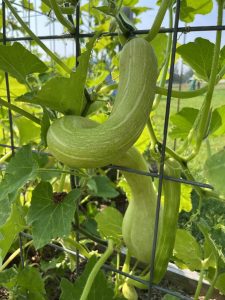
Photo by Kate Garland.
So, what am I able to do? I have found that if I do some stretching first, I can often last longer outside. I have also found certain tools that help immensely. One of the tasks I can reliably do is deadheading. I have a pair of scissors with a spring that helps me cut for short periods due to arthritic hands. If there are lots of dead flowers, I sit on a stool to do the task. To remove runners from my strawberry plants (which I use as ground cover around two fruit trees), I sit on the ground on a cushion and scoot onto a second cushion next to me when it’s time to clip the next plant. Later, watching me get back up off the ground is not a pretty sight! For light pruning, I use a ratchet bypass hand pruner which fits my hand. Once in a while, for short periods of weeding, I practiced the yoga forward bend posture: this is not available to me anymore so I now use a semi-squat. Although most of the garden is covered by a weed-suppressing mulch of composted manure, which also provides nutrients, there are a few areas where I can use a scuffle hoe (alias stirrup or hula) to weed.
I also use a propane weed-burning cane-like tool to kill weeds between stones in a path and my stone driveway. I have a dandelion weeder that’s on a long handle. During my hip replacement recuperation since I couldn’t bend down, I also used my kitchen grabber tool to pick up the dandelions and put them in a bucket. On hot, humid days I’m a wuss, so I either lay my 6′ lightweight beach umbrella on its side or stick it in the ground and weed under it. Because I have rosa rugosa cultivars, as well as raspberries, I have Japanese beetles galore. So, I put a little squirt of Dawn into a quart spray bottle, fill it with water, and spray the flowers only on those plants…voila no more beetles…until it rains, when I reapply. Masked, I sprinkle bloodmeal around my blueberries to keep the bears (seriously…three of them) away. I wrap all handles (rake, broom, scuffle hoe, etc.) with duct tape so I don’t have to grasp them so hard. Once in a while I use foam and wrap it onto a thinner handle to build it up.
I’ve made a small 6’ x 20′ vegetable garden surrounded by chicken wire. I grow carrots, onions, beets, kale, beans, peas, lettuce, and some cukes in it. The only help I need with this garden is spreading compost in the fall. Tomatoes, rhubarb, and squashes are grown all around the greater landscape. I keep track of where things have grown in the past and make sure to rotate crops. Once the squashes have emerged, I spend a portion of time daily picking off squash and cucumber beetles. I learned that putting diatomaceous earth (masked again) around the base of each plant will kill the emerging larva. The herb garden takes care of itself somewhat. I do like to use some herbs for seasoning, and dry for tea, sachets, or creams. I’ve given up on plants like corn and sunflowers because of the difficulty of removing and disposing of the stalks in the fall. I’ve got to pick my battles!
I have a Prius hatchback, so I can easily haul many garden-related objects. I keep a small tarp in the trunk so when I purchase things like shrubs, a straw bale, or cedar bark mulch for my paths, the trunk doesn’t get dirty. I used to lay out the tarp and ask the loader to place the articles so that I could easily unload them by sliding the object into my garden cart, onto a wide base dolly, or onto a plastic sled (wheelbarrows were too clumsy for me). These things I used to move myself, but are now not possible.
Being careful about the choices I make with plant selection, I found that most shrubs take less care than most perennials and some perennials take less care than others. In the fall, when it’s time to cut back the fleshy plants, I tie string around the plant. Then I can easily use my hedge trimmer to cut them down. I put the tied-up bunch in the car and drive it to the city dump, unload, untie, and the string comes home with me. Because of the way the wind blows here, I have few leaves. I live by the woods, so I can still use a leaf blower to move the leaves into the woods without needing to rake and bag. This year I’ve had to stop using my reciprocating saw to cut woody plants and to hack my winter squashes in half for baking. I loved that saw! Now I need my helpers to rev it up.
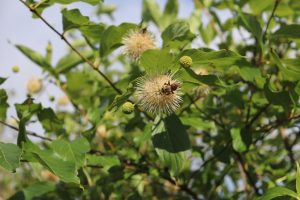
(Cephalanthus occidentalis)
Photo credit: Art Shaw.
I think my best experience here on Earth has been to help other folks learn how to enjoy and be successful in growing plants. I especially like using my edible landscape as a teaching garden. I want to share the bounty my helpers have supported me in producing. These are things I can do and hope to continue to do for quite a while. But this senescence of my physical self has been difficult for me. It’s been a gradual progression (see above) of loss, as though every day is a new normal of what I still can and cannot do. I guess I’m concerned about when I will run out of creative, adaptive ideas.
Here are some book and article resources by other passionate gardeners that you may find helpful. The authors provide different ways to manage garden spaces to help others continue to follow their gardening passion:
- Gardening Through Your Golden Years, by Jim Wilson of the Victory Garden
- Accessible Gardening, by Joann Way
- Gardening Without Work, by Ruth Stout
How to Keep on Gardening as We Get Older – The Real Dirt Blog – ANR Blogs (ucanr.edu)
Collecting Ash Seed in Maine
By Lynne Holland, Horticulture Professional, University of Maine Cooperative Extension

Summer is the start of a harvest season that can extend well past the fall equinox. Seed gathering is an activity of many traditions both in Europe and North America. Without these traditions, the heritage varieties of many food crops would not still be available and research into new strains would not be possible. However, this article is not about collecting seeds to grow food: rather, it is about collecting seeds to help protect cultural heritage from an invasive species. The Ash Protection Collaboration Across Wabanakit (APCAW) is now preparing for its second seed collection season.
The Emerald Ash Borer (EAB) is a fairly new threat to Maine. However, other parts of North America have seen the devastation of ash trees in a relatively short period once that invasive pest moves into an area. Ash is interwoven through the culture and heritage of the Wabanaki Confederacy. More specifically it is Brown/Black Ash (Fraxinus nigra), a native plant in Maine that is culturally important and at risk. More information and resources about the Wabanaki people and ash can be found on the APCAW website. Seed collection from ash trees is one strategy in the protection and regeneration of the brown/black ash species due to the effects of EAB. These seeds can be used for research to identify potential strains that are genetically resistant to this pest. These seeds can also be used to create a seed bank that could be used for the propagation and regeneration of the species in areas impacted by EAB.
Brown/Black Ash is a tree found throughout Maine but generally in lower numbers than White or Green Ash, and often in small stands. Partners in APCAW have been preparing for the coming of EAB for twenty years. The need for a seed collection guide was identified, and in response, Emily Francis, PhD., created a guide and APCAW website page with this information. Now that the tools have been identified, the next step is coordinating the effort. Seed collecting is an impactful step in which landowners, land trusts, and citizen scientists can actively participate. This is generally done in September or October. If you are interested in getting involved in seed collection, Ella McDonald or John Daigle are the people to contact. They can connect you to local seed collection groups or materials.
Brown/Black Ash seed collection is not always possible every year since they typically seed every five to eight years. However, it is always good for landowners/land trusts to annually inventory and monitor ash stands. Forest Trees of Maine and this Maine Forest Service website both are helpful resources for ash identification. The APCAW website also has more information on seed collection and reporting as well as monitoring and managing ash trees.
If this is a topic of interest to you then consider attending the conference Future of Brown Ash: Weaving Indigenous Knowledge and Western Science to Promote Resilience amidst Emerald Ash Borer Invasion on October 8th-9th in Orono, Maine. This event is a series of talks, collaborative meetings, and field trips. More information can be found on the registration form and the flier included in this article.
Collecting seeds at harvest is a pretty straightforward activity that can be both rewarding and beneficial. Reach out to a local land trust or keep an eye out for events posted on the APCAW webpage. If you are a landowner, collecting seeds is a simple yet impactful act in the face of the invasive Emerald Ash Borer. The collection, processing, and storage of ash seed will help with current and future research and regeneration efforts.
Featured Tool: Say Hello to the Homi
By Naomi Jacobs, Penobscot County Master Gardener Volunteer
Most American gardeners depend on familiar hand tools like a trowel, claw-like cultivator, and weeder for working “up close and personal” with plants. But my new favorite hand tool is an ancient option from another culture: the Korean homi. Versions of this traditional tool have been found at Iron Age and Bronze Age excavations. The long-handled homis were used as we would use a hoe, for tasks such as planting and cultivating rice. Specific types were developed for wet and dry fields and for different soils. The ubiquity and affordability of the tool gave rise to the expression “Only a fool would steal a homi.” In fact, the homi was so crucial to farming and gardening that cleaning and hanging up one’s homi indicated that the season of cultivation was done.
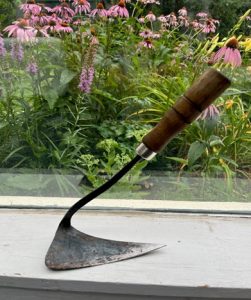
Photo credit: Naomi Jacobs.
The short-handled homi, now widely available in the West, combines the functions of a trowel, hand cultivator, and weed digger in one lightweight, well-balanced tool. Its business end consists of a triangular iron blade, bent back toward the user. This ergonomic arrangement takes full advantage of the arm’s pulling power and the elbow’s flexibility of movement. The narrow point slides easily into the soil, making way for the flat, sharp side of the triangle to cut weed roots or loosen a seed bed with less effort than a trowel. You can use the point to draw a furrow and the flat surface to close the furrow and press the soil down after sowing. The homi works equally well for getting under individual weeds with deeper roots like dandelions and for scraping off multiple shallow-rooted weeds near other plants. It is really a pleasure to use.
The homi is easy to order online, sometimes listed as a “ho-mi” or “Korean hand plow.” Look for a hand-forged product with a continuous blade and tang rather than one where two pieces of metal have been joined together. Also, choose the wide, back-swept triangular blade rather than a different tool also marketed as a homi, which has a narrow blade set at a right angle to the handle.
Once you’ve tried a homi, you might very well find it’s the only hand tool you need.
Sources:
- Griffin, Annaliese. “A traditional Korean garden hoe has become the “it” tool for spring”. Quartz. Retrieved 2024-05-04.
- “Homi (tool).” Wikipedia. Retrieved 2024-05-09.
- Kim Ji-myung. “An unknown hallyu ― ’homi.’” Korea Times. Retrieved 2024-05-09.
The Best Salts for Canning & Pickling
July 18, 2024 Food Preservation, Spoonful
By Mary Kate Reny, UMaine Extension Master Food Preserver Volunteer
Salt has been used to preserve food for centuries—salted fish, corned meat, and olives come to mind. But is salt required when preserving vegetables? I was surprised to learn that—except for fermentation—any veggie may be canned without salt. It is added for flavor only and is not needed to prevent spoilage. However, plenty of wonderful recipes call for salt, and it’s a must for those briny pickles we’ll be putting up soon, right?
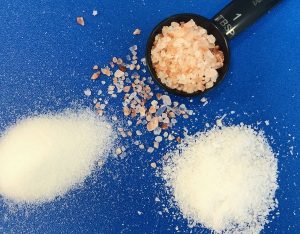
With so many salts to choose from—table salt, kosher salt, Celtic Sea salt, pickling salt, Real salt, Himalayan salt, and a myriad of flaky, finishing salts that run the gamut of flavors for cooking and baking—does it matter which one is used when preserving vegetables? Yes, yes it does!
Because salt crystals come in a variety of shapes and sizes, they aren’t interchangeable by volume in a recipe. For example, a third of a cup of kosher salt (with its larger crystals) does not have the same density as a third of a cup of pickling salt. To get an accurate measure, you would need to measure it by weight, using a scale. By weighing your salt instead of simply measuring it, you quickly realize how easy it is to over- or under-salt your recipe.
It’s also important to consider the mineral content and additives in salt when canning. The pink hue in Himalayan salt, for example, is due to non-soluble minerals, which may discolor some veggies and will end up undissolved in the bottom of your jar. Additives such as iodine and an anti-caking agent are present in regular table salt, which can make your brine cloudy and darken or discolor your vegetables.
For these reasons, the USDA recommends using canning or pickling salt for home food preservation. Pickling salt is pure salt—sodium chloride (NaCl)—with nothing added. It is easy to find and takes the guesswork out of accurate measuring. Pickling salt dissolves easily and keeps the brine clear so you can admire the gorgeous outcome of your canning efforts.
Whether you’re an old salt at canning or just starting, a canner worth their salt will make sure that their food preservation techniques stay up-to-date (insert groan or eye roll here). Happy canning!
Resources
- General Pickling FAQs (National Center for Home Food Preservation)
- Salts Used in Pickling (National Center for Home Food Preservation)
Backyard Bird of the Month: Scarlet Tanager
By Andy Kapinos, Maine Audubon Field Naturalist
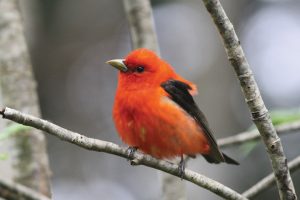
Photo credit: Doug Hitchcox.
Despite being one of the most boldly patterned birds in the eastern woodlands, Scarlet Tanagers are seldom seen. Males are bright red with black wings, and females are yellow-green with black wings. They only nest in deep, deciduous forests, and spend most of their time high in the canopy of oaks, maples, and birches. The foliage at this height is full of insects and their larvae, the primary food source for Scarlet Tanagers. If you are lucky enough to see one, it is usually while it is moving methodically along a branch, gleaning caterpillars or moths as it goes. They eat a significant number of bees and wasps, apparently undeterred by the stings. You may even see them carry a mouthful of insects back to a well-hidden nest, often in the mid-canopy, with vegetation above and below. The best way to find them, though, is by their distinctive song: the male’s song is a bit like a raspy robin, with several blurry phrases in quick succession. Scarlet Tanagers also give distinctive two-part calls to each other that sound like “chip-churr”. During fall migration, beginning later this month, tanagers will pass through many areas, including those without enough forest to support nesting. They often spend more time eating fruits during migration, so keep an eye out for them lower down in shrubs like viburnums and dogwoods. Scarlet Tanagers are true neotropical migrants, returning to the Amazon basin during the northern winter. This species’ habitat is protected by multiple, overlapping conservation initiatives, including bird-friendly maple sugaring, forestry, and coffee-growing. They are yet another species we can see in our backyards that requires habitat conservation throughout its range, from Peru, Maine to Perú.
Maine Weather and Climate Overview (August 2024)
By Dr. Sean Birkel, Assistant Extension Professor, Maine State Climatologist, Climate Change Institute, Cooperative Extension University of Maine
NOAA statewide temperature and precipitation data for Maine rank June 2024 as 4th warmest (top 1/10) and 40th wettest (top 1/3) for records beginning 1895. An early-season heatwave in the third week of the month contributed to the monthly temperature ranking, where temperatures reached into mid to high 90s °F and some areas set or tied high-temperature records for either daytime highs or overnight lows. NOAA statewide means for July are not yet available, but station observations show the month as much warmer than normal with near-normal precipitation. The average of daily temperatures July 1–28 observed in Bangor (72.4°F), Caribou (70.0°F), and Portland (73.4°F) rank 3rd (Bangor, Caribou) and 2nd warmest (Portland) for the respective records beginning 1953 or earlier. The high rankings in July are due to atmospheric patterns that persistently brought heat and humidity from the Gulf of Mexico and subtropical North Atlantic for most of the first three weeks. Despite the stretch of hot weather, precipitation was sufficient to maintain normal soil moisture, streamflow, and groundwater for this time of year in most parts of the state. However, York County, Cumberland County, and some mid-coast areas did not receive as much rainfall from convective storms as other parts of the state and currently register as abnormally dry on the U.S. Drought Monitor. See the Northeast Drought Early Warning System for precipitation and hydrology information.
The latest 10-day weather forecast (starting July 29th) and the 6–10-day outlook products from the NOAA Climate Prediction Center indicate that the first part of July will see above-normal temperatures and a lean toward above-normal precipitation. The Weeks 3–4 outlook shows above normal temperature and an equal chance of above or below normal precipitation. Similarly, the three-month August–September-October outlook shows above-normal temperature and a lean toward above-normal precipitation. The latest weather forecast for your area is available from weather.gov.
| Product | Temperature | Precipitation |
|---|---|---|
| Days 6-10: Aug 3-7 (issued July 28) | Above Normal | Lean Above Normal |
| Weeks 3-4: Aug 10-23 (issued July 26) | Above Normal | Equal Chance |
| Seasonal: Aug-Sep-Oct (issued July 18) | Above Normal | Lean Above Normal |

For questions about climate and weather, please contact the Maine Climate Office.
Do you appreciate the work we are doing?
Consider contributing to the Maine Master Gardener Development Fund. Your dollars will support and expand Master Gardener Volunteer community outreach across Maine.
Your feedback is important to us!
We appreciate your feedback and ideas for future Maine Home Garden News topics. We look forward to sharing new information and inspiration in future issues.
Subscribe to Maine Home Garden News
Let us know if you would like to be notified when new issues are posted. To receive e-mail notifications, click on the Subscribe button below.
University of Maine Cooperative Extension’s Maine Home Garden News is designed to equip home gardeners with practical, timely information.
For more information or questions, contact Kate Garland at katherine.garland@maine.edu or 1.800.287.1485 (in Maine).
Visit our Archives to see past issues.
Maine Home Garden News was created in response to a continued increase in requests for information on gardening and includes timely and seasonal tips, as well as research-based articles on all aspects of gardening. Articles are written by UMaine Extension specialists, educators, and horticulture professionals, as well as Master Gardener Volunteers from around Maine. The following staff and volunteer team take great care editing content, designing the web and email platforms, maintaining email lists, and getting hard copies mailed to those who don’t have access to the internet: Abby Zelz*, Annika Schmidt*, Barbara Harrity*, Kate Garland, Mary Michaud, Michelle Snowden, Naomi Jacobs*, Phoebe Call*, and Wendy Robertson.
*Master Gardener Volunteers
Information in this publication is provided purely for educational purposes. No responsibility is assumed for any problems associated with the use of products or services mentioned. No endorsement of products or companies is intended, nor is criticism of unnamed products or companies implied.
© 2023
Call 800.287.0274 (in Maine), or 207.581.3188, for information on publications and program offerings from the University of Maine Cooperative Extension, or visit extension.umaine.edu.
